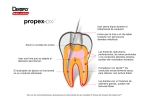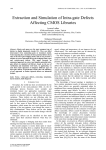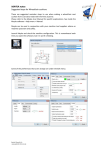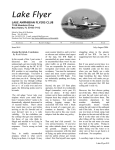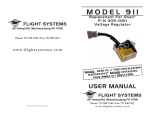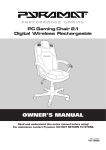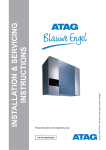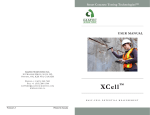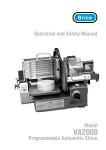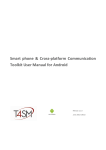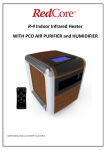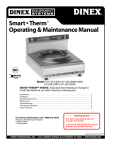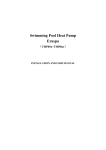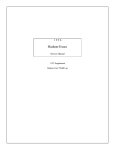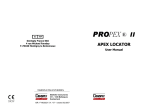Download INSTALLATION MANUAL
Transcript
INSTALLATION MANUAL Civil Engineering Fabrics PETROTAC® INSTALLATION GUIDE CONTENTS PART I - WHAT PETROTAC® IS AND WHAT IT DOES PETROTAC® INSTALLATION CHECKLIST PART II - MATERIALS AND EQUIPMENT FOR INSTALLATION A. PETROTAC® MEMBRANE B. PRIMER C. MASTIC D. INSTALLATION EQUIPMENT PART III - INSTALLATION PROCEDURES A. APPLICATIONS B. SURFACE PREPARATION C. PRIMER PLACEMENT D. PETROTAC® PLACEMENT E. TEMPORARY TRAFFIC F. PAVING OPERATIONS APPENDICES APPENDIX A: SELF-ADHERING PAVING STRIP MEMBRANE GUIDE SPECIFICATION APPENDIX B: BRIDGE DECK SELF-ADHERING PAVING STRIP MEMBRANE GUIDE SPECIFICATION APPENDIX C: RECOMMENDED PRIMERS AND MASTICS PART I - WHAT P ETROTAC ® IS AND WHAT IT DOES Petrotac® is an easy to install "peel and stick" pavement repair membrane. Petrotac® also makes an excellent bridge deck membrane. Petrotac® provides all the benefits of Propex's Petromat® System and is readily applied to localized areas of pavement distress. Petrotac® is a waterproofing membrane that effectively seals pavement joints, cracks and repaired potholes, as well as bridge decks. The Petrotac® membrane also forms a stressrelieving interlayer beneath the pavement overlay, retarding reflective cracking and resisting fatigue cracking. This Installation Guide provides important information to help you install Petrotac® properly and safely. Because no guide can cover every installation condition, our experienced Propex representatives are available to offer additional guidance. They will be pleased to answer your questions and provide installation support for your special project conditions. Call 1-800-621-1273 For Your N earest Propex Distributor PETROTAC ® INSTALLATION CHECKLIST SURFAC E PREPARATION (page 5 and 6) • Clean off dirt, water and debris • Correct areas of subgrade failure • Fill cracks greater than 3/8" wide • Allow emulsified or cutback asphalt crack filler to cure PRIMER PLACEMENT (page 7) • Is primer required? • Use an Propex-approved primer • Allow primer to cure completely PETROTAC ® PLACEMENT (page 7 and 8) • Verify pavement temperature > 45°F and rising • Place the Petrotac® • Placement for cracks and joints • Placement for bridge decks • Roll or smooth the Petrotac® after placing • Overlap panels 4" • On bridge decks, use mastic to seal joints and edges • Implement traffic precautions PAVING OPERATIONS (page 11) • Use locally approved products and procedures • Verify that Petrotac® and pavement surfaces are dry • Use standard pre-paving tack coat • Place minimum compacted overlay thickness of 1½" P ART II - MATER IALS A ND EQUIP MENT FOR INSTA LLATION A. P ETR OTAC ® MEMBRA NE Material - Petrotac® is a composite membrane consisting of two layers: an asphalt saturated paving fabric coated with a high quality rubberized asphalt adhesive. The main component of Petrotac® is Propex's Petromat® paving fabric, a nonwoven polypropylene fabric designed specifically for pavement repair. The top surface of the fabric is presaturated with asphalt cement tack coat. No extra tack coat, other than the standard paving tack coat, is needed on top of the Petrotac® during overlay placement. This unique feature of Petrotac® saves construction time and cost because it eliminates the extra tack coating step needed with other products. The pre-saturated fabric also ensures an excellent bond with the overlay. Beneath the fabric is the second layer, a rubberized asphalt adhesive. The strong adhesive sticks readily to asphalt, concrete and wood surfaces. The adhesive is protected by a release sheet, which is removed just prior to placement. Sample construction specifications for Petrotac® for pavement repair and bridge deck applications are included as Appendix A and B of this Installation Guide. Storage and Handling -The Petrotac® rolls are individually packaged in corrugated boxes. It is preferable that the boxes be stored standing up to prevent the rolls from developing a flat side. Store the Petrotac® in a dry location at temperatures not exceeding 140°F. In colder weather, keep the material as warm as possible. Avoid storing the product outside overnight. This will make the material easier to handle and keep the rubberized adhesive layer tacky. Avoid getting the Petrotac® wet. Moisture can make the release paper weak and difficult to remove. When storing outdoors, cover the Petrotac® rolls and elevate off the ground so that rain and runoff cannot get into the material. Use care in handling and storing the Petrotac® to avoid damage to the membrane. Don't drop the boxes or handle them roughly. This can tear the edges of the release paper and make it difficult to peel off. B. P RIMER The purpose of a primer is to improve adhesion of the Petrotac® under "marginal" conditions that tend to reduce bonding. The primer penetrates the surface of the pavement to be treated with Petrotac®. This provides a clean surface which bonds extremely well to Petrotac's® rubberized asphalt adhesive. Primers are generally not needed under normal construction conditions where the pavement is hot and dry. Conditions that require primers are detailed in Section III.C of this Installation Guide. The primer should be composed of refined asphalt and a rapid drying solvent. A list of suitable primers is included as Appendix C. C . MAS TIC The purpose of a mastic, or sealant, is to provide a seal around the edges of the installed Petrotac® for certain critical waterproofing applications, such as on bridge decks. The mastic should be a trowel-grade material and is applied using a trowel or a large caulk gun. Appendix C includes a list of mastics recommended by Propex. D. IN STALLATIO N EQUIP MENT The Petrotac® "peel and stick" membrane can be installed quickly by a two-person crew with no special equipment. The following is all that is needed: • • • • Brushes, paint rollers or spray equipment to apply primer, if it is required Utility knives to cut the material. A length of rope to guide the roll during laydown, if needed. Pneumatic rolling equipment (pneumatic roller, pickup truck or other truck) to smooth the fabric and increase the bond. Stiff bristle push brooms can also be used to enhance adhesion of the Petrotac® to the pavement. P ART III - IN STA LLATION P ROCEDUR ES A. AP PL ICA TI ONS Petrotac® membranes are effective in treating cracks, potholes and other localized areas of pavement distress. Petrotac® is also used to seal bridge decks and pavement joints. Petrotac® can be used on both asphalt cement concrete (ACC) and Portland cement concrete (PCC) pavements and on ACC, PCC, wood and steel bridge decks. W hen more generalized or widespread protection is needed, we recommend using Propex's Petromat® paving fabric repair system. This section addresses the following construction steps, providing general guidance for installing the Petrotac® in most conditions. § § § § § Surface preparation Primer placement Petrotac® placement Temporary traffic Paving operations For additional guidance on special conditions, please call on Propex's technical representatives (1-800-621-1273). B. SURFA CE P REPA RATIO N The first step is preparing the pavement or bridge deck surface to receive the Petrotac®. Before beginning the project, determine what surface preparation will be required. Give careful attention to areas that show signs of structural or subgrade distress, such as severe alligator cracking, spalling or pavement deformation. For severe damage, the engineer should specify procedures for removing and replacing or stabilizing the questionable pavement area. Surface C leaning - It is important that the surface on which the Petrotac® membrane is placed is free of dirt and completely dry. There should be no lingering moisture around pavement cracks. Moisture from cracks or damp pavements can cause problems with adhesion of the Petrotac® membrane. Sweep off accumulations of dirt, debris, vegetation and other foreign matter. Compressed air or brooming can be used to effectively clean bridge decks and clean out pavement cracks. Repair o f Distressed Areas - Areas of slight to moderate alligator cracking, where the pavement structure is still stable, can be treated directly with Petrotac®. Areas of severe alligator cracking or pavement subsidence may indicate localized subgrade distress or pavement base failure. These pavement areas should be excavated and replaced before sealing with the Petrotac®. In some cases, a leveling course may be adequate. The engineer should specify such remedial measures. Repairs should be done in accordance with procedures recommended by The Asphalt Institute or local highway departments. C rack Treatment - Pavement cracks greater than 3/8" wide should be cleaned out and filled with a stable crack filler, such as hot or cold asphalt mix, emulsion slurry or commercially available crack filler. Fill cracks flush with the existing pavement surface and remove excess crack filling material. If the crack filler contains an emulsified asphalt or cutback asphalt, allow it to cure for at least 24 hours or until completely cured (whichever is longer) before placing the Petrotac®. This will allow water and volatiles in the crack filler to dissipate rather than becoming trapped under the membrane, which can reduce the bond between Petrotac® and the pavement surface. P rep aration o f Mil led Surfaces - Milled surfaces must be cleaned com pletely using compressed air to remove fines and dust. Milled or highly textured bridge deck surfaces may need a leveling course to provide the necessary smooth surface. A leveling course will also be required where grooves in milled pavements result in vertical surfaces. P rep aration o f Brid ge Decks - Bridge decks tend to retain some moisture. For this reason, proper preparation of bridge decks is especially important to enable good bonding of the Petrotac®. Before applying Petrotac®, the bridge surface must be com pletely dry and clean. Bridge decks always require a prime coat (see Section III.C, below). If the deck surface is milled or highly textured, a leveling course may be needed to provide the necessary smooth surface. A leveling course will also promote adhesion of the Petrotac®. Wooden bridge decks that are new or heavily treated with preservatives may need additional cleaning so that the Petrotac® can adhere to the wood. Excess preservative can be removed with a scraper. Mineral spirits can be used to remove creosote from the surface of the wood. The deck should be cleaned such that the wood is visible. Certain wood preservatives contain oils that can react adversely with Petrotac’s® rubberized asphalt coating. This problem has been identified on decks freshly treated with Penta‚ wood preservative. If you plan to place Petrotac® on a bridge deck that is treated with Penta‚, contact a Propex representative to discuss methods for effective installation. One method is to separate the Petrotac from the Penta‚ by placing an asphalt concrete leveling course. P rep aration o f C oncrete P avements - New PCC pavement surfaces should be cleaned of all curing or forming compounds. PCC pavement slabs should be stable and differential movement at joints should be corrected. Subsided slabs may be leveled to the proper grade using either hot mix asphalt or Portland cement concrete. Other repair methods include milling or slab jacking. Joints should be filled like pavement cracks, as described previously. C . P RIMER P LAC EMENT The purpose of a primer is to improve adhesion of the Petrotac® under "marginal" conditions that tend to reduce bonding. Such conditions include moisture, dust, cold temperatures and irregular surfaces. Primer also improves adhesion of Petrotac® to the pavement in cases where there will be temporary traffic on the Petrotac®. If these conditions are not present, primers are not normally required. Always apply a prime coat prior to installing Petrotac® for bridge deck applications. Always use a prime coat in any case where the Petrotac® may be exposed to moisture combined with traffic prior to overlay. The use of a primer is also recommended if there is residual dust on the surface or if the pavement temperature is below 70°F. No prime coat is needed when the pavement is clean, dry and at a temperature of 70°F or above. The primer should be placed in accordance with the recommendations of the manufacturer. Primer can be sprayed on or applied in a continuous thin coat with brushes or paint rollers. The prime coat application should be a paint-like covering, generally requiring one gallon to cover 200 to 400 square feet depending on the surface texture and the primer used. The primer must cure completely before the Petrotac® is placed. The cure time depends on the type of primer used. A list of suitable primers and their cure times is included as Appendix C of this Guide. When the ambient temperature is 60°F or below, we recommend applying the primer a day early and letting it cure overnight. When the primer has cured, all the cutting agent has evaporated off. The surface will be tacky to touch but will not come off on your hand. Any ponded spots should be brushed thin and allowed to cure thoroughly. D. P ETR OTAC ® P LAC EMENT This section provides general guidelines and step-by-step procedures for installing the Petrotac® for the following applications: § § Pavement cracks, joints, potholes and other localized distressed areas Bridge decks The main difference in the procedures is that proper alignment and overlapping are critical for bridge deck applications. General Guidelines T e m p e r a t u r e - The pavement temperature should be at least 45°F and rising when installing Petrotac®. A primer should be used if the pavement temperature is below 70°F. It is preferable that the Petrotac® be placed during warmer weather. In colder weather, the prime coat (if used) takes longer to cure and the membrane's rubberized asphalt adhesive layer becomes less tacky. In cold conditions, keep the Petrotac® as warm as possible. Avoid storing the product outside overnight. This will make the Petrotac® easier to unroll and handle, and will help retain tackiness. Small pavement areas to be patched may be heated with a torch to remove moisture and promote adhesion. DO NOT directly heat the Petrotac® membrane this way. Be sure to pneumatically roll the Petrotac® to ensure a good bond with the pavement. Cold weather problems with adhesion of the Petrotac® can be reduced by immediate placement of the overlay. Overlaps - Overlap adjacent Petrotac® panels by 4". The overlap line is marked on the 36" wide Petrotac®. Make sure that overlapping sections are clean and dry. The overlaps should "shingle" in the direction of overlay placement, which is usually the direction of traffic. On grades, start at the lower end and work up, so that the overlaps are shingled in the direction of water runoff. For example, on a road surface that has a center crown, start at the lower curb and work toward the center. Joints or cracks to be sealed may extend in different orientations. For example, joints in a Portland cement concrete pavement extend in both the transverse and longitudinal directions. To minimize the potential for peeling of the membrane during paving operations, apply the Petrotac® strips to transverse joints first. Then apply the Petrotac® to the longitudinal joints. The longitudinal strips laid in the direction of paving, on top of the transverse strips, will help keep the edges of the transverse strips from being peeled up at the overlaps by paving equipment. Stee p grades - ACC pavements on steep grades are more prone to asphalt shoving and delamination. This is particularly true in areas of hard stopping or turns. Care should be taken during construction in these areas. Petrotac® can be installed on pavement grades and super elevation grades of up to 8 percent without increasing the potential for these problems. Petrotac® can be installed on grades of up to 10 percent depending on existing pavement surface, overlay thickness, ACC materials, construction procedures and traffic volumes. Contact your Propex representative prior to placing Petrotac® on slopes between 8 and 10 percent. P etro tac ® P lacement for C racks and Joints - Installation of the Petrotac® "peel and stick" membrane is a simple task, accomplished easily by a two-person crew. The following installation guidelines apply to pavement cracks, joints and potholes. Establish alignment - With the release sheet still attached, place the Petrotac® roll at one edge of the treatment area and position it to establish the intended alignment. Center the roll over the joint or crack to be sealed. Anchor the roll - The Petrotac® must extend at least 6" onto sound pavement beyond the ends and sides of the joint, cracked area or pothole. Peel back the release paper at one end, exposing 12 to 18 inches of the adhesive, and stick the membrane to the pavement to anchor the roll. Unr oll the membrane - Walk backwards pulling the release paper. This unrolls the membrane, exposing the adhesive and sticking down the fabric. A length of rope can be inserted through the roll and pulled to guide the roll along the intended alignment. Collect the discarded release paper during the unrolling process and dispose of it in an empty Petrotac® box. MEMBRANE PLACEMENT Position the Petrotac® roll over the area to be treated. The Petrotac® must extend beyond the crack or joint by at least 6”. 1. Unroll 20’ to 25’ to establish directional alignment of the Petrotac® strip. Do not remove the release sheet from the adhesive membrane. 2. Cut the release sheet, as shown, with a utility blade. Be careful not to cut the Petrotac® membrane. 3. Pull the top portion of the cut release sheet as indicated, unrolling the Petrotac® membrane and exposing the adhesive asphaltic membrane. 4. Re-roll the initial 20-25’ strip. Pull the release sheet, unrolling the Petrotac® in the opposite direction and completing the operation. The release paper can be re-rolled and stored in the empty box for easy disposal. Adjacent Petrotac® strips should be overlapped 2”to 4”. Overlaps should be in the direction of traffic. Place additional panels - Repeat these steps with additional Petrotac® panels to cover the area. For a crack that curves or changes direction, simply cut the Petrotac® and realign a new piece, following the new direction of the crack. Remember to overlap adjacent panels by 4", shingled in the direction of traffic, and extend the fabric at least 6" onto sound pavement. Small applications - For smaller applications such as potholes, or when the working space is limited, it can be easier to pre-cut the Petrotac® to the required length. Simply cut a piece of fabric to the length needed, position it to establish the directional alignment, anchor the roll by sticking down the adhesive at one end, and unroll and place as described above. Smooth the surface - After installation, we recommend rolling the Petrotac® for a tight bond with the underlying pavement. Smooth wrinkles, and slit and smooth bubbles under the membrane. Use a pneumatic roller, pickup truck or similar wheeled equipment for smoothing. Stiff bristle brooms can also be used, especially on smaller installations. P etro tac Placement for Bridg e Decks - For bridge deck installations, it is critical that the Petrotac® be aligned and overlapped properly to provide a continuous waterproof membrane. Prepare the bridge deck as described in Section III.B, including the application of a primer to the bridge deck and install the Petrotac® in accordance with the following guidelines. Establish alignment - Once the membrane is placed it can't be moved or straightened. It is therefore critical that proper alignment be established and maintained throughout the installation on bridge decks. Position the first roll along the curb or edge railing of the deck so that it will unroll parallel to the bridge. With the release sheet still attached, unroll 10' to 20' of fabric to establish the intended alignment. Step on the 10' to 20' alignment strip at one end to anchor it. This alignment strip will be tacked down last. Cut the release sheet - Cut the release sheet beyond the initial alignment strip, as shown, with a utility knife. Be careful not to cut the Petrotac® membrane. Unr oll the membrane - Pulling the cut release sheet, walk backwards, unrolling the membrane, exposing the adhesive and sticking down the fabric. A length of rope can be inserted through the roll and pulled to guide the roll along the intended alignment. Collect the discarded release paper during the unrolling process and dispose of it in an empty Petrotac® box. Tack down alignment strip - Once the Petrotac® is unrolled and stuck to the pavement, go back and tack down the initial alignment strip. Simply re-roll the 10' to 20' strip and pull the release paper, unrolling the strip in the opposite direction of the in-place fabric. This completes the laydown operation for one roll. Place additional panels - Repeat these steps with additional Petrotac® panels. Be sure to carefully align each panel and maintain the required 4" overlap. The overlap line is marked on the 36" wide Petrotac®, which is the width used for bridge deck installations. We recommend applying mastic, or sealing compound, along the Petrotac® side and end overlaps and along the edge of the membrane at the curb to ensure a watertight seam on bridge deck installations. A list of mastics suitable for this use is included in Appendix C of this Guide. Smooth the surface - After installation, we recommend rolling the Petrotac® for a tight bond with the underlying pavement. Smooth wrinkles, and slit and smooth bubbles under the membrane. We recommend applying an approved mastic (see Appendix C) to the slit. Use a pneumatic roller, pickup truck or similar wheeled equipment for smoothing. P etro tac ® P lacement for P avem ent P enetrations At drains, manholes, expansion joints or other penetrations, place the Petrotac® over the opening. Then cut out the material around the inside of the opening. Apply a bead of mastic around the opening to provide a good seal. A list of mastics appropriate for this use is included in Appendix C. E. TEMP ORAR Y TRAFFIC Once the Petrotac® is installed it can be paved over immediately. However, if necessary, traffic can be permitted on the membrane before the overlay is placed. Such traffic exposure should be only temporary, and must be approved by the engineer. Harsh traffic conditions, such as high speeds, turning, and braking, should be avoided, as they may be detrimental to the performance of the Petrotac®. Petrotac ® can be slippery when wet. If local conditions require traffic on the membrane, safety precautions must be taken to limit the possibility of a skidding hazard. Th ese include, but are not limited to, speed reductions and warning signs to alert drivers that the surface may be slippery when wet. F. P AV ING OP ERATION S The overlay can be placed immediately after the Petrotac® has been installed. Paving operations should use products and placement methods approved by local agencies. First, place a standard paving tack coat over the membrane and pavement. The use of cutbacks is not recommended. The top surface of the Petrotac® is pre-coated with asphalt cement tack coat so that no extra tack coat, other than the standard paving tack coat, is needed on top of the Petrotac® during overlay placement. Thi s unique featur e of P etrotac ® saves construction time and cost because it eliminates the extra tack coating step needed with other p rod ucts. The pre-saturated fabric also ensures an excellent bond with the overlay. Standard paving operations follow tack coat placement. The overlay should be designed based on the anticipated traffic and installed in accordance with the specifications. A minimum compacted asphalt thickness of 1½" is recommended. In rare cases, shoving or humping of a very hot or soft overlay may occur during compaction at the juncture of the smooth Petrotac® and rough original pavement surface. If this occurs, solve the problem by simply slowing the roller to reduce the shear forces. Also, wait for the hot mix to cool somewhat, while staying within acceptable compaction temperatures. Figure 2 Petrotac ® Sizes and App lications Wi dth (in) Leng th (f t) 12 18 24 36 108 108 108 45 Gross weig ht (lb s) 45 66 88 53 Typ ical Ap plications Straight, narrow cracks and joints Curved or "wandering" cracks and joints Cracks, joints, potholes Bridge decks, alligator-cracked areas, potholes APPENDIX A: SELF-ADHERING PAVING STRIP MEMBRANE GUIDE SPECIFICATION DESCRIPTION This work shall consist of furnishing and placing an asphalt-coated paving fabric reinforced membrane over pavement cracks, joints and other pavement distress areas prior to placement of a pavement overlay. The membrane shall be installed as indicated on the plans and contract documents. MATERIAL REQUIREMENTS The pavement repair membrane shall be a nonwoven, needle-punched, polypropylene fabric coated with rubberized asphalt adhesive on the bottom and top-coated with an asphalt tack coat. A release sheet, which is removed just prior to placement, shall cover the adhesive. The membrane shall meet the physical requirements specified in Table 1. Table 1 Physical Requirements of Pavement Repair Membrane P roperty Test Method Units Strip tensile ASTM D 8822 lb/in 50 Puncture resistance ASTM E 154 lb 200 Permeance ASTM E 96 perms 0.05 (max) Method B ASTM D 1463 N/A No cracks in fabric or rubberized asphalt Pliability Val ue 1 Notes 1 Minimum average roll values unless otherwise noted 2 Using 12 in/min test speed and 1" initial distance between grips 3 Using 180° bend on ¼" mandrel at -25°F Materials shall be stored and handled in accordance with the manufacturer's recommendations. Incidental materials recommended by the manufacturer for proper membrane installation, such as primer, tack coat, and mastic, shall be furnished and used in accordance with the manufacturer's recommendations. USE Pavement repair membrane is used for repair of pavement cracks, joints, and other pavement distress areas. It is applied in strips over cracks and joints in Portland cement or bituminous concrete pavements. The membrane adheres to the existing surface and is then overlaid with a bituminous concrete overlay using standard paving procedures. The pavement repair membrane shall be installed in accordance with the manufacturer's recommendations and the following requirements. P rep aration o f existing surf ace - The pavement surface shall be cleaned of dirt and other foreign materials. The surface shall be completely dry, with no lingering moisture around pavement cracks. Cracks greater than 3/8" in width shall be filled with a suitable crack filler. Areas of severe alligator cracking or pavement subsidence shall be excavated and replaced prior to membrane application. If necessary, Portland cement concrete slabs shall be stabilized. P rimer placement - When required, a primer shall be furnished and placed on the prepared pavement as specified by the membrane manufacturer. Use of a primer is recommended if the pavement temperature is below 70°F. No prime coat is needed when the pavement is clean, dry and at a temperature is 70°F or above. Membrane placement - The pavement repair membrane shall be centered over joints and cracks to be treated and shall be rolled after placement. Transverse joints and cracks shall be treated before longitudinal joints. Should a crack require more than one strip, the strips shall be overlapped at least 4" in the direction of paving. Any wrinkles or bubbles in the membrane shall be repaired as specified by the manufacturer. Membrane that is damaged due to the Contractor's operations shall be removed and replaced at the Contractor's expense. The installed membrane shall be approved by the Engineer prior to paving operations. Overlay p lacem ent - A standard pre-paving tack coat shall be applied over the pavement and pavement repair membrane. Paving mix should be applied as specified in the plans and contract documents; however, a compacted overlay thickness of less than 1½" is not recommended. Vehicle traffic - If necessary, traffic can be permitted on the membrane before the overlay is placed. However, as a safety precaution, such traffic should be only temporary and must be approved by the Engineer. Harsh traffic conditions, such as high speeds, turning, and braking, should be avoided. Warning signs shall be posted to alert drivers that the surface may be slippery. Signs shall also post a safe speed. Tem perature - The pavement temperature shall be at least 45°F and rising for membrane installation. MEAS UR EMENT AN D P AYMEN T The pavement repair membrane will be measured in place by the square yard, without credit for overlaps. The accepted quantities of pavement repair membrane will be paid for at the contract unit price per square yard in place. APPENDIX B: BRIDGE DECK SELF-ADHERING STRIP MEMBRANE GUIDE SPECIFICATION DESCRIPTION This work shall consist of furnishing and placing an asphalt-coated paving fabric reinforcedmembrane on a repaired, widened, or new bridge deck prior to placement of a bituminous concrete overlay. The membrane shall be installed as indicated on the plans and contract documents. MATERIAL REQUIREMENTS The bridge deck strip membrane shall be a nonwoven, needle-punched, polypropylene fabric coated with rubberized asphalt adhesive on the bottom and top-coated with an asphalt tack coat. A release sheet, which is removed just prior to placement, shall cover the adhesive. The membrane shall meet the physical requirements specified in Table 1. Table 1 Physical Requirements of Bridge Deck Membrane Property Test Method Units Value1 Strip tensile ASTM D 8822 lb/in 50 Puncture resistance ASTM E 154 lb Permeance ASTM E 96 Method B ASTM D 1463 perms 0.05(max) N/A No cracks in fabric or rubberized asphalt Pliability 200 Notes 1 Minimum average roll values unless otherwise noted 2 Using 12 in/min test speed and 1" initial distance between grips 3 Using 180° bend on ¼" mandrel at -25°F Materials shall be stored and handled in accordance with the manufacturer's recommendations. Incidental materials recommended by the manufacturer for proper membrane installation, such as primer, tack coat, and mastic, shall be furnished and used in accordance with the manufacturer's recommendations. USE Bridge deck membrane is used to provide a continuous waterproof membrane on bridge decks of Portland cement concrete, bituminous concrete, wood and steel. It is applied in strips and overlapped to form a continuous membrane sheet. The membrane adheres to the deck surface and is then overlaid with a bituminous concrete overlay using standard paving procedures. The bridge deck membrane shall be installed in accordance with the manufacturer's recommendations and the following requirements. Preparation of existing surface - The bridge deck surface shall be cleaned of dirt and other foreign materials and shall be completely dry. Cracks greater than 3/8" in width shall be filled with a suitable crack filler. Areas of pavement distress shall be repaired prior to membrane application. Excess preservative on wooden bridge decks must be removed. Primer placement - A primer shall be furnished and placed on the prepared deck surface as specified by the membrane manufacturer. The primer must cure completely before the bridge deck membrane is placed. Membrane placement - The bridge deck membrane shall be placed parallel to the bridge, starting at the low or downslope side of the deck. Adjacent membrane strips shall be overlapped at least 4" in the direction of water runoff. The membrane shall be rolled after placement. Additional mastic shall be applied at the membrane edges as recommended by the manufacturer. Any wrinkles or bubbles in the membrane shall be repaired as specified by the manufacturer. Membrane that is damaged due to the Contractor's operations shall be removed and replaced at the Contractor's expense. The membrane to be installed shall be approved by the Engineer prior to paving operations. Overlay placement - A standard pre-paving tack coat shall be applied over the deck surface and bridge deck membrane. Paving mix should be applied as specified in the plans and contract documents; however, the compacted overlay thickness should not be less than 1½". Vehicle traffic - If necessary, traffic can be permitted on the membrane before the overlay is placed. However, as a safety precaution, such traffic should be only temporary and must be approved by the Engineer. Harsh traffic conditions, such as high speeds and braking, should be avoided. Warning signs shall be posted to alert drivers that the surface may be slippery. Signs shall also post a safe speed. Temperature - The pavement temperature shall be at least 45°F and rising for membrane installation. MEASUREMENT AND PAYMENT The bridge deck membrane will be measured in place by the square yard, without credit for overlaps. The accepted quantities of bridge deck membrane will be paid for at the contract unit price per square yard in place. APPENDIX C: RECOMMENDED PRIMERS AND MASTICS A. PRIMERS The primers listed below may be used with Petrotac® for roadway and bridge deck applications when primer is needed to ensure a good bond. All primers listed are compatible with Petrotac® and bituminous and Portland cement concrete surfaces. Many other asphalt-based primers can be used. Check with your Propex representative for compatibility with Petrotac®. The following notes apply to the primer list below: § § § The primer curing times shown are a guide only. Actual curing time will depend on weather conditions, such as ambient temperature, relative humidity, wind and sunny versus cloudy conditions. When the ambient temperature is 60°F or below, we recommend applying the primer a day early and letting it cure overnight. The primer has cured when all the cutting agent has evaporated off. The surface will be tacky to touch but will not come off on your hand. Any ponded spots should be brushed thin and allowed to cure thoroughly. Primer Curing Time Manufacturer and Address Reed & Graham Petrotac Primer ¼ - 1 hr Reed & Graham, Inc. 3630 Business Drive, #124 Sacramento, CA 95820 (916) 454-2662, (800) 544-2560 Vance Brothers Primer P-I 1 - 3 hrs Vance Brothers, Inc. 5201 Brighton Kansas City, MO 64180 (816) 923-4325 Vance Brothers Primer P-II ¼ -1 ½ hrs same as above 108 AF Asphalt Primer 1 - 3 hrs Karnak Corporation 330 Central Ave. Clark, NJ 07066 (201) 339-0855, (800) 526-4236 Henry 104 Primer (105 Primer, CA only) ¼ - 1 hr W. W. Henry Company 2911 Slauson Ave. Huntington Park, CA 90255 (213) 583-5000 Fields 400 Asphalt Primer 1 - 3 hrs Fields Corporation 2240 Taylor Way Tacoma, WA 98421 (206) 627-4098, (800) 627-4098 Bonsal Sealer ¼ - 1 hr W. R. Bonsal Company 8201 Arrowridge Blvd. Charlotte, NC 28210 (704) 525-1621, (800) 738-1621 Primer Curing Time Manufacturer and Address Celotex Asphalt Primer 1/4 - 2 hrs The Celotex Corporation P.O. Box 22602 Tampa, FL 33622 (813) 873-1700, (800) 334-5567 Gibson-Homans 6001 Primer 4 - 8 hrs Gibson-Homans 1755 Enterprise Parkway Twinsburg, OH 44087 (216) 425-3255, (800) 433-7293 Grundy Concrete Primer 1 - 4 hrs Grundy Industries, Inc. 1301 Herkimer Street Joliet, IL 60432 (815) 726-5087, (800) 435-1210 Trem Prime, Quick Dry 1 - 2 hrs Tremco 10701 Shaker Boulevard Cleveland, OH 44104 (216) 292-5000 B. MASTICS The mastics (adhesives) listed below may be used for roadway and bridge deck applications to provide a seal around the edges of the Petrotac® and to seal overlaps, when required. All listed mastics are compatible with Petrotac® and bituminous and Portland cement concrete surfaces. Many other elastomeric mastics can be used. Check with your Propex representative for compatibility with Petrotac®. Mastic Manufacturer and Address Bulldog Modified SBS Palmer Asphalt Company P.O. Box 58 Bayonne, NJ 07002 (201) 339-0855, (800) 352-9898 Karnak AR Elastomeric Karnak Corporation 330 Central Avenue Clark, NJ 07066 (908) 388-0300, (800) 526-4236 Poly Roof Tremco 10701 Shaker Boulevard Cleveland, OH 44104 (216) 292-5000 Wet Bond Cement Fields Corporation 2240 Taylor Way Tacoma, WA 98421 (206) 627-4098, (800) 627-4098 Mastic Manufacturer and Address MP-51 Lap Cement Seaboard Asphalt Company 3601 Fairfield Road Baltimore, MD 21226 (410) 355-0330, (800) 536-0332 Henry 209 Elastomastic Henry Company 2911 Slauson Avenue Huntington Park, CA 90255 (213) 583-5000 Wet-R-Dri Roof Cement Gardner Asphalt 4001 Seventh Avenue Tampa, FL 33675 (813) 248-2101, (800) 237-1155 In Florida - (800) 282-1155 TESTED. PROVEN. TRUSTED. www.geotextile.com Propex Operating Company, LLC ⋅ 6025 Lee Highway, Suite 425 ⋅ PO Box 22788 ⋅ Chattanooga, TN 37422 ph 423 899 0444 ⋅ ph 800 621 1273 ⋅ fax 423 899 7619 ® ® ® ® ® ® ® Geotex , Landlok , Pyramat , X3 , SuperGro , Petromat and Petrotac are registered trademarks of Propex Operating Company, LLC. This publication should not be construed as engineering advice. While information contained in this publication is accurate to the best of our knowledge, Propex does not warrant its accuracy or completeness. The ultimate customer and user of the products should assume sole responsibility for the final determination of the suitability of the information and the products for the contemplated and actual use. The only warranty made by Propex for its products is set forth in our product data sheets for the product, or such other written warranty as may be agreed by Propex and individual customers. Propex specifically disclaims all other warranties, express or implied, including without limitation, warranties of merchantability or fitness for a particular purpose, or arising from provision of samples, a course of dealing or usage of trade. © 2011 Propex Operating Company, LLC




















